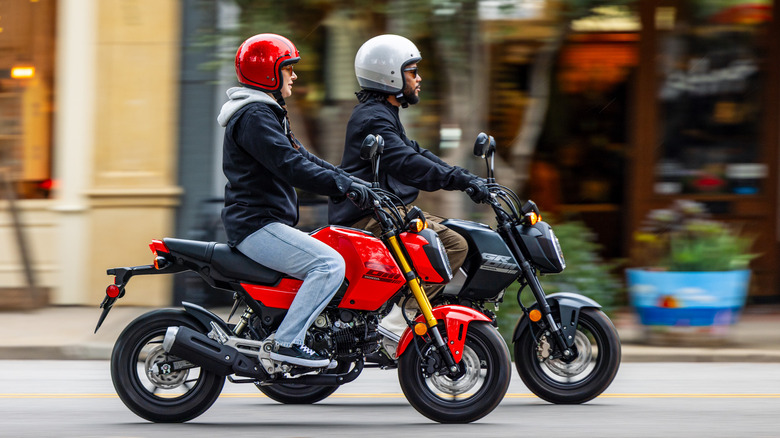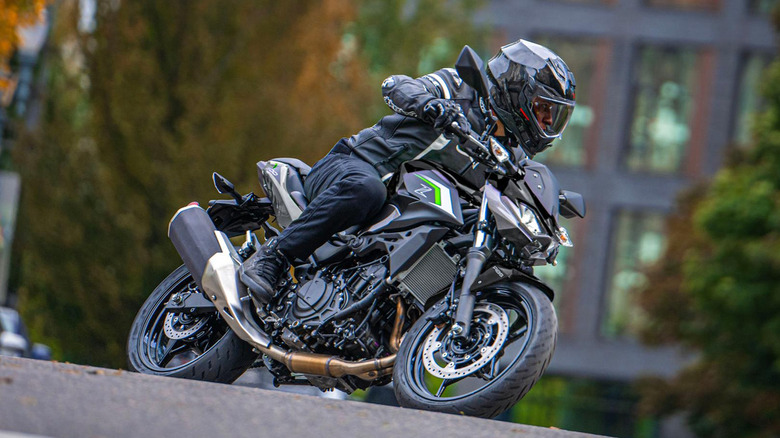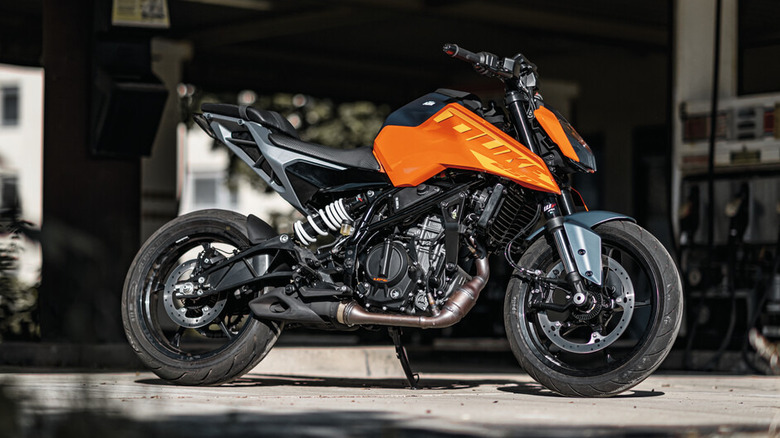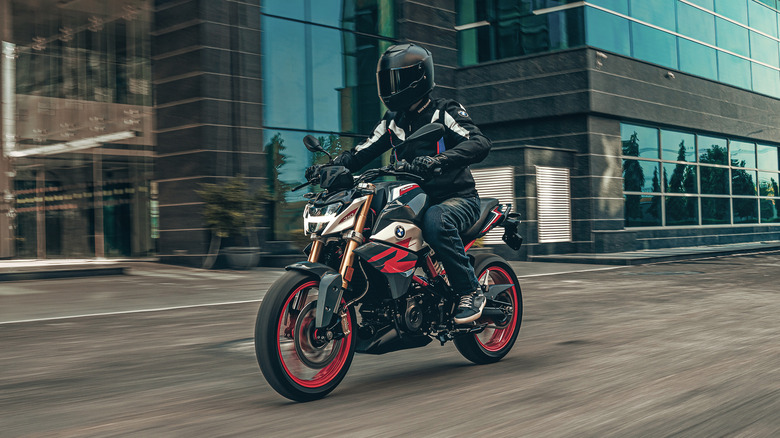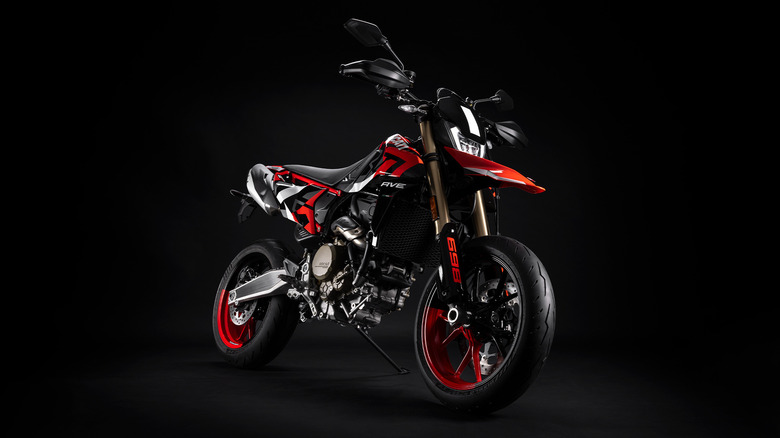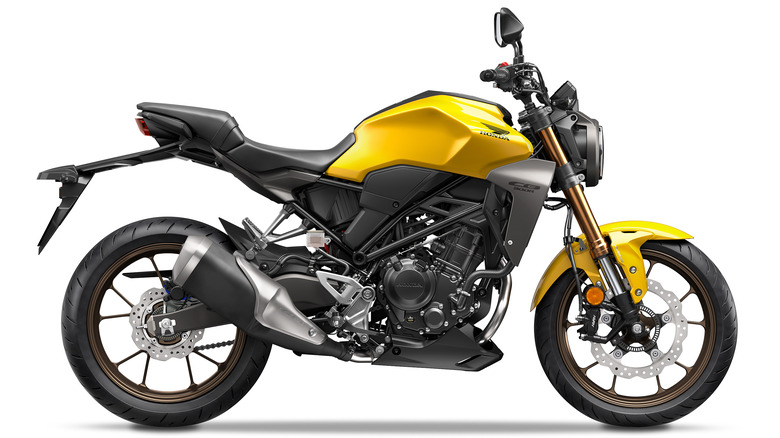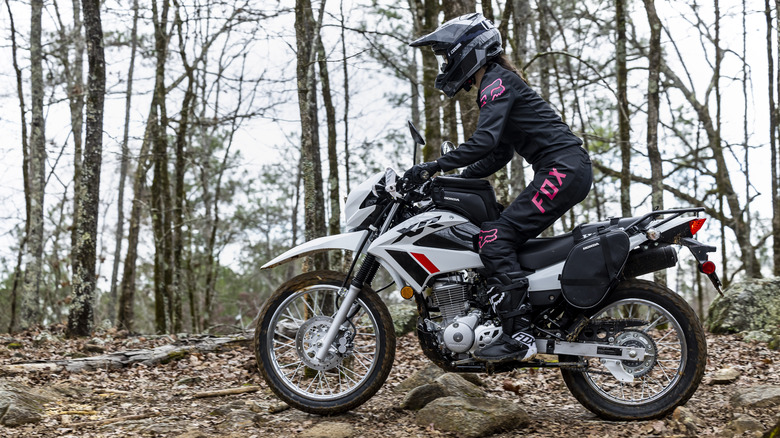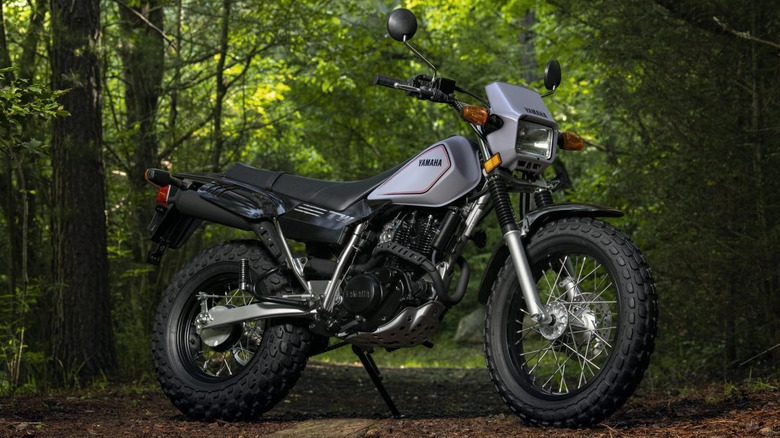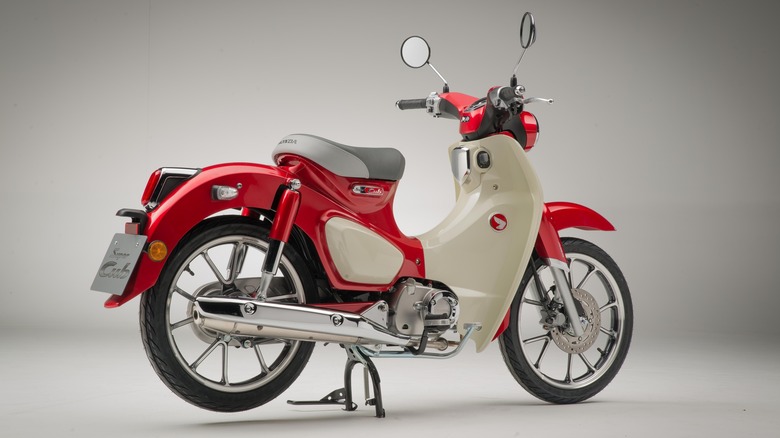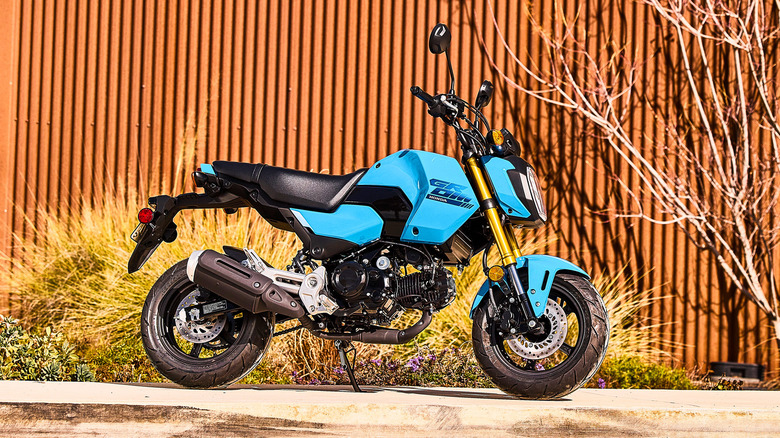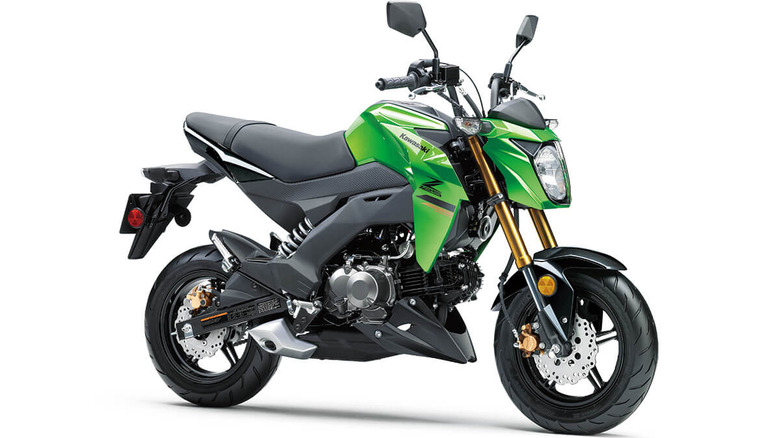10 Of The Lightest Motorcycles On The Market In 2024
Sure, we all get excited about motorcycles with huge engines, but squeezing a beefy engine into a chassis isn't the only way to make a great motorcycle. Many brands also offer bikes that take the opposite route, focusing on compactness and lightness. These motorcycles may not make the most power ever, nor will they have the most astounding straight-line speed or torque, but their low weight and agility make them great for newbies, city riders, and anyone looking to split lanes to cut down on their commute.
To that end, we've highlighted 10 of the lightest motorcycles you can buy in 2024 across various displacements. You'll see more than a few Honda motorcycles on our list, simply because it's arguably the king of small, lightweight bikes. Still, the Japanese company is far from the only name in town as far as lightweight bikes go — even if its 125-cc mini motorcycles are some of the best (and lightest) out there.
For the sake of variety, we opted to go beyond the featherweight 125-cc motorcycles to include a few larger-displacement bikes that stay under 400 pounds — an arbitrary limit, perhaps, but one that we're comfortable with. We've also decided to stick to street-legal bikes, so don't expect to see any ultra-light off-road-only bikes here. With all that out of the way, let's get started.
Kawasaki Z500: 370 pounds
Kawasaki's Z500 is a brand-new member of its famed Z-series of motorcycles, which debuted back in 1972 with the Z1. While it shares a name with the Z650-derived Z500 from 1979, the 2024 Z500 bears little in common with its predecessor from nearly 50 years ago — beyond being a naked bike, that is.
The 2024 Kawasaki Z500 is essentially the naked cousin of the 2024 Kawasaki Ninja 500, with Kawasaki developing the two bikes alongside each other. It replaces the Z400, which is no longer part of the Kawasaki lineup for 2024. Despite having 500 in the name, the Z500 actually has a 451 cc engine. Slightly misleading, perhaps, but it's still a good, solid engine that's capable of producing 51 hp and 31.7 lb-ft of torque.
It's also a parallel twin, unlike many other bikes that weigh in at less that 400 pounds. So while its 370-pound curb weight makes the Z500 one of the heavier bikes on our list, you're getting something in return. It's still a reasonably light bike in the grand scheme of things, though, which — combined with the low 30.9-inch seat height — makes it a maneuverable and easy-to-ride motorcycle for newer riders. Cycle World came to that exact conclusion in its first ride, praising the Z500's combination of good performance and beginner-friendliness.
Kawasaki sells two versions of the Z500: the Z500 ABS and Z500 SE ABS. The latter has extras like a full-color TFT display and LED turn signals. The basic Z500 goes for $5,599, while the SE's goodies bump the MSRP to $6,299.
KTM 390 Duke: 363 pounds
For most of its life, the 390 Duke was the baby brother of the signature KTM Duke range in the U.S. However, with the new KTM 250 Duke coming to the U.S. in 2024, KTM saw fit to update the 390 Duke alongside it, bringing it closer to its bigger brothers while retaining its accessible charms.
The 2024 390 Duke packs a 398 cc LC4c (liquid cooled, four-valve, compact) engine making around 45 hp and 28.8 lb-ft of torque. You're not going to tear up the drag strip with the 390 Duke, but the engine has enough grunt to make the 390 Duke a fun, if not necessarily fast, ride, especially combined with all the other improvements — such as a stiffer chassis and adjustable front and rear suspension — introduced for 2024.
The changes seem to have worked wonders, with Motorcycle.com enthusiastically praising the mid-sized Duke's confident cornering ability. The 32.3-inch seat height is higher than other beginner-focused bikes, but the overall weight – 363 pounds with fuel — and handling should still make this a great newbie bike, especially with its three riding modes helping rein things in depending on conditions. KTM has set a $6,299 U.S. MSRP for the 390 Duke.
BMW G 310 R: 362 pounds
BMW introduced the G 310 R in 2015 as its first-ever roadster with an engine smaller than 500 cc. Powered by a then-new 313 cc liquid-cooled single-cylinder engine making 34 hp and around 21 lb-ft of torque, the 362-pound bike carried the ethos and design language of BMW's larger roadsters into a smaller, more accessible package.
BMW's main point of pride in the G 310 R is the engine — but not necessarily its displacement or power output. Instead, the engine's main selling point is its backward cylinder layout, which allowed BMW engineers to place the intake at the front and route the exhaust out the rear. BMW claims that this moves the center of gravity toward the front wheel, improving handling and making for a more compact bike overall.
While all of this could so easily be marketing talk, independent reviews do seem to back BMW's claims up. The combination of a forward center of gravity, a long swing arm, and 54.3-inch wheelbase make for a bike that takes corners brilliantly. NZ Autocar tested the 2023 model and found that it offered a stable yet nimble ride, with the 31-inch seat height making it great for beginner — and shorter — riders.
Other notable features include a radial front brake setup, more commonly seen on high-performance motorcycles, and ABS as standard. The current G 310 R also sports an automatic idle boost, electronic throttle, and an anti-hopping clutch — all of which were added in a 2020 update — at a decent $4,995 MSRP.
Ducati Hypermotard 698 Mono: 333 pounds
Lightweight motorcycles are usually small, basic, relatively low-powered, and affordable, targeted as they are at beginner riders seeking an approachable bike. Don't tell that to Ducati, though, as its Hypermotard 698 Mono is a big-bucks road-going Supermotard motorcycle meant for serious enthusiasts.
The Hypermotard 698 Mono debuted in 2024 as the Italian marque's first single-cylinder Supermotard, joining the ranks as a little brother to the Hypermotard 950 motorcycles. The 698 Mono has a 659 cc Superquadro Mono engine making an impressive 77.5 hp and 46.5 lb-ft of torque. Cycle World enjoyed the engine greatly, praising its low-end power and impressive engine.
It's also quite a lot of power considering the 698 Mono's weight. Ducati quotes 333 pounds, but that's without gas — we estimate that the 698 Mono will weigh closer to 350 pounds once you fill up its three-gallon fuel tank — assuming six pounds per gallon of fuel. Even at 350 pounds, though, it's still a remarkably light motorcycle for a full-sized bike with a 35.6-inch seat height.
The Ducati also packs a lot of tech, with three engine power modes and four riding modes — Sport, Urban, Road, and Wet — determining various rider aids such as ABS, wheelie control, and traction control. You also get a fully adjustable fork and shock for more serious track-day shenanigans. Of course, all of this goodness comes at a price — in the U.S. pricing starts at $12,995.
Honda CB300R: 316 pounds
The Honda CB300R is very possibly one of the lightest production motorcycles you're going to find in the U.S. with an engine larger than 200 cc. While most motorcycles weighing less than 300 pounds have to make do with 125 to 200 cc engines, the CB300R packs a comparatively massive 286 cc engine that makes 31 hp and 20.3 lb-ft of torque. While those numbers admittedly pale compared to the larger motorcycles on our list, the single-cylinder engine's numbers are adequate when considering its low 316-pound curb weight. It's not going to be a fast motorcycle per se, but the low weight helps the CB300R get up to speed quicker than you might expect.
Introduced to the U.S. market in 2018, the CB300R is part of Honda's Neo-Sports Café range of motorcycles, which includes excellent naked bikes like the CB650R. The CB300R is a beginner-friendly take on the archetype with an what Motorcyclist found to be an excellent combination of an accessible 31.5-inch seat height, lower-powered engine, and comfortable, full-size ergonomics. All these traits also help make it an great motorcycle for newer riders or anyone seeking a more relaxed ride.
Yes, you can easily buy lighter motorcycles — in fact, Honda makes more than a few of them — but none of them will have the power and café racer appeal of the CB300R. You're not giving up too much, either, with 316 pounds still being incredibly light by most standards. The 2024 CB300R has an MSRP of $5,149.
Honda XR150L: 282 pounds
Honda's XR150L is its low-cost and lightweight entry into the dual-sport motorcycle market, attempting to muscle in on the Yamaha TW200's territory in the U.S. Technically, the XR150L isn't a new model, as it debuted in 2003 in the Asian and Latin American markets. However, it took until 2023 for Honda to bring the XR150L to North American markets.
A 150-cc single-cylinder engine capable of around 11 hp and 8.3 lb-ft of torque powers the XR150L. That's enough to have fun in a compact, 282-pound motorcycle, especially with its broad torque curve and excellent responsiveness across the rev range. Our own Michael Teo Van Runkle spent some time on the 2023 XR150L and praised the bike's beginner-friendly nature and enjoyable riding experience. Like many dual-sport motorcycles, the XR150L rides on larger tires than usual, sporting a 19-inch front tire and 17-inch rear. These help it do well off-road, of course, but also absorb small obstacles and shocks better, making for a smoother and friendlier ride.
The XR150L is a primitive motorcycle by modern standards, with no rider aids or modern lighting. Still, there's something to be said for simplicity, especially for new riders — especially when it comes with the benefit of a low price. The simplicity also helps the XR150L rank as one of the most affordable dual-sport motorcycles in the U.S., with an MSRP of $3,099 for the 2024 model.
Yamaha TW200: 278 pounds
The Yamaha TW200 has been around for decades, debuting in 1987 and remaining mostly unchanged ever since. Sure, Yamaha did add disc brakes and an electric starter in 2001, but the TW200 has otherwise been the same chunky-tired, 200 cc dual-sport motorcycle it was when it launched — and, if you ask its many admirers, that's for the better.
Yamaha doesn't publish power numbers for most of its motorcycles, but the consensus is that the air-cooled engine makes around 16 hp and 11 lb-ft of torque, give or take a few horses. That's more than enough power for a motorcycle that weighs 278 pounds, with Motorcyclist pointing out that the engine in the 2023 model is good enough for riding at freeway speeds. Sure, it won't get you where you need to go at amazing speeds, but it's more than adequate for road and dirt — the latter thanks to its knobby and balloon-style 18 and 14-inch front and rear tires.
As with many lightweight bikes, the TW200 has a newbie-friendly geometry, with a 31.1-inch seat height that should allow most riders to flat-foot it without problems. It's also a simple motorcycle, with a feature set that wouldn't be out of place on something from the 1980s. For example, you'll have to live with a rear drum brake, and you don't get fancy LED lights or LCD instrument panels. Still, retro simplicity and gloriously boxy 1980s styling can be good fun, too — although you will have to cough up around $5,000 for the privilege.
Honda Super Cub C125 ABS: 238 pounds
Honda's Super Cub has also been around for ages, having first entered production in 1958. It's been a fixture of the Japanese giant's two-wheeler program ever since, remaining in constant production — internationally, at least — since then, with over 100 million units produced globally as of 2017. Honda stopped selling the Super Cub in the U.S. in 1974 but reintroduced the model as the Super Cub C125 ABS in 2019.
The Super Cub C125 ABS has a 125 cc, single-cylinder engine, which it uses across its range of mini motorcycles, which Honda affectionately calls miniMOTOs. The engine makes 9.7 hp and 7.7 lb-ft of torque, more than enough for a bike that only weighs 238 pounds. The Super Cub's signature is its underbone design, which lets riders step through (instead of over) to get on the motorcycle, lowering the barrier of entry and helping it appeal to as many riders as possible.
It's not as small as some of its fellow miniMOTOs, with a 30.7-inch seat height and a 48.9-inch wheelbase. In the opinion of Rider Magazine, these dimensions, combined with the Super Cub's 17-inch wheels, help the C125 feel more like a conventional motorcycle than other compact offerings. It's still tiny, mind you, but you will be more visible, which is helpful for those dealing with dicey traffic. Befitting its vintage styling and heritage, the Super Cub C125 is an extremely minimal bike, with a semi-automatic four-speed transmission and ABS the only features to speak of. The 2024 Honda Super Cub C125 ABS is available at an MSRP of $3.899.
Honda Grom: 224 pounds
Honda's Grom is one of the Japanese company's many tiny 125 cc and below urban motorcycles and likely one of the most loved. The Grom debuted in 2014 and was an immediate hit with reviewers, with outlets such as Cycle World and RideApart loving the pint-sized motorcycle.
The Grom has the same 125-cc single-cylinder engine that powers other mini Honda bikes, making 9.7 hp and 7.7 lb-ft of torque. Hardly earth-shattering numbers, but that's not the point as the Grom is all about lightweight, compact fun, with its 224-pound weight letting you make use of every single horsepower that tiny engine makes. The Grom debuted with a four-speed transmission, but Honda dropped in a five-speed unit for 2022's third-generation Grom, which has remained mostly unchanged into 2024.
The Grom's tiny size — a 30-inch seat height and 47.2-inch wheelbase make for a small bike — and low weight make it a fun, nimble ride. It's not a speed demon, but it's perfect for bombing around town and using that tiny engine to its fullest — all while still being comfortable enough for Cycle World's 6-foot-4 reviewer to ride without any deal-breaking ergonomic complaints.
Honda's Grom is as basic as motorcycles get, with few features or creature comforts, but that's not surprising at its $3,599 MSRP. The Grom ABS adds front-wheel anti-lock for an extra $200 (and a three-pound weight increase).
Kawasaki Z125 Pro: 224 pounds
The Kawasaki Z125 Pro is the company's answer to Honda's ever-popular Grom. Debuting in 2017, the Z125 Pro is a 125 cc, single-cylinder motorcycle that treads an eerily similar path to Honda's class-leading mini bike. It has a slightly higher seat height at 31.7 inches and a slightly shorter wheelbase at 46.2 inches but is recognizably a compact, fun motorcycle in the Grom's mold. It weighs 224 pounds wet, which is essentially identical to the Grom, and the engine makes similar numbers, too.
Kawasaki claims 7.1 lb-ft of torque from the engine, with aftermarket tests providing an 8.3 hp power number. Not the most powerful engine ever, but a motorcycle this small and light doesn't need a lot of power to be fun. Cycle World tested the Z125 Pro when it debuted and appreciated its nimble handling and broad appeal, combining a beginner-friendly nature with a fun side that could keep more experienced riders entertained. The stock handlebar position was a bit cramped for their six-foot-plus reviewer, and things, unfortunately, don't seem to have changed much in the years since — tall riders may want to experiment with aftermarket handlebars.
You do have to live with a four-speed transmission instead of the 2022 and onward Grom's five-speed, but that's likely not a huge deal for commuting in town. The only major omission is perhaps the lack of an ABS model, but that's not too bad on a small bike — especially one with a starting MSRP of $3,649.
